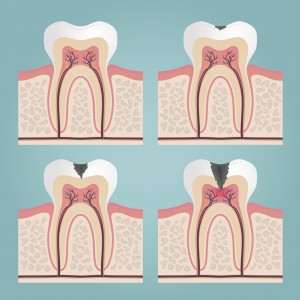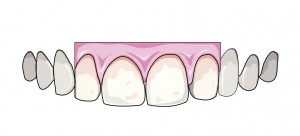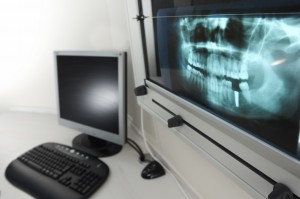Dental crowns should feel comfortable, and they shouldn’t cause pain. Crown tooth pain is a signal that something is wrong, and you need to correct it.
There are several reasons that you might experience crown tooth pain. Keep reading if you haven’t been able to figure out how to get rid of your crown tooth pain.

An infection in the pulp of a tooth (pulpitis) can be painful.
Infection after a tooth crown
If a crown is over an existing tooth and a root canal wasn’t performed, the tooth still has nerves running to it. The nerves and connective tissue are in the center of the tooth, or the pulp. If an infection occurs in the pulp, it is called pulpitis, and it can be painful.
Crown trauma
If a dental crown does not fit well, especially if it is too high, the teeth opposite the crown will hit it with force. This trauma can cause pain, especially around the gum of the dental crown.
 Recessed gum line
Recessed gum line
The gum line around a dental crown can recede over time, exposing sensitive areas of the gum and increasing the chance of infection.
 Tooth fracture
Tooth fracture
The tooth underneath the crown is still alive and still subject to fracture and wear. Pain can come from a cavity or fracture in the tooth. Read more about cracked dental crowns here.
How we can help with crown tooth pain

No matter the problem, we can help. For any problem, you need to know what’s wrong before you can then fix it.
- Infection: Your prosthodontist will be able to track down the source of the infection. Then they’ll treat with medication, but they’ll also make sure that the cause of the infection is removed as well. This might mean replacing the original crown, but until you have an assessment, there is no way of knowing the remedy.
- Trauma: Your prosthodontist can easily adjust your crown to reduce the trauma. Our on-site Laboratory makes fitting and customizing crowns simple.
- Recessed Gum Line: If gum disease results because of receding gums along the crown line, your dentist can extend the crown or offer a new solution for repair, such as a bridge or a dental implant.
- Tooth Fracture: The treatment for a fractured or cracked tooth under a crown will depend on the severity of the fracture. If your dentist can’t save the remainder of the tooth under the crown, there are several alternatives, for example bridges or implants. These are both great replacements for a crown.
Each situation is unique and so is each solution. Read more about Common Dental Crown Problems here.
To sum up, you shouldn’t be experiencing crown tooth pain. Call and make an appointment as soon as possible, so that Dr. Stone can assess the problem and find a solution that will relieve your pain and restore your smile.
Contact us today to request an appointment for a free consultation.


 Recessed gum line
Recessed gum line Tooth fracture
Tooth fracture